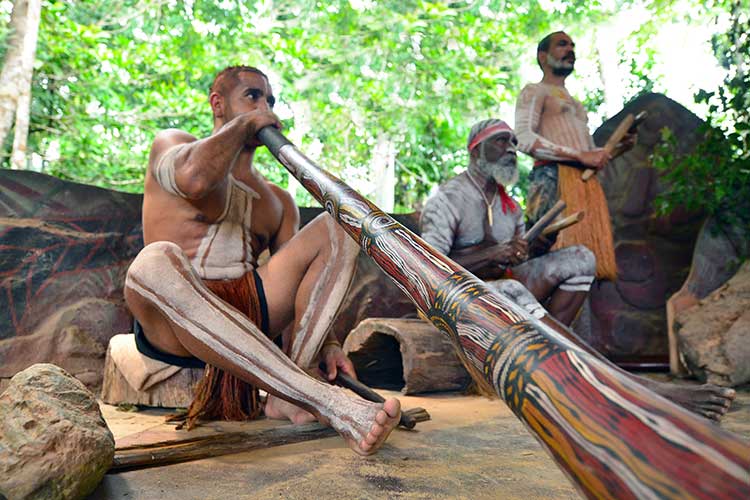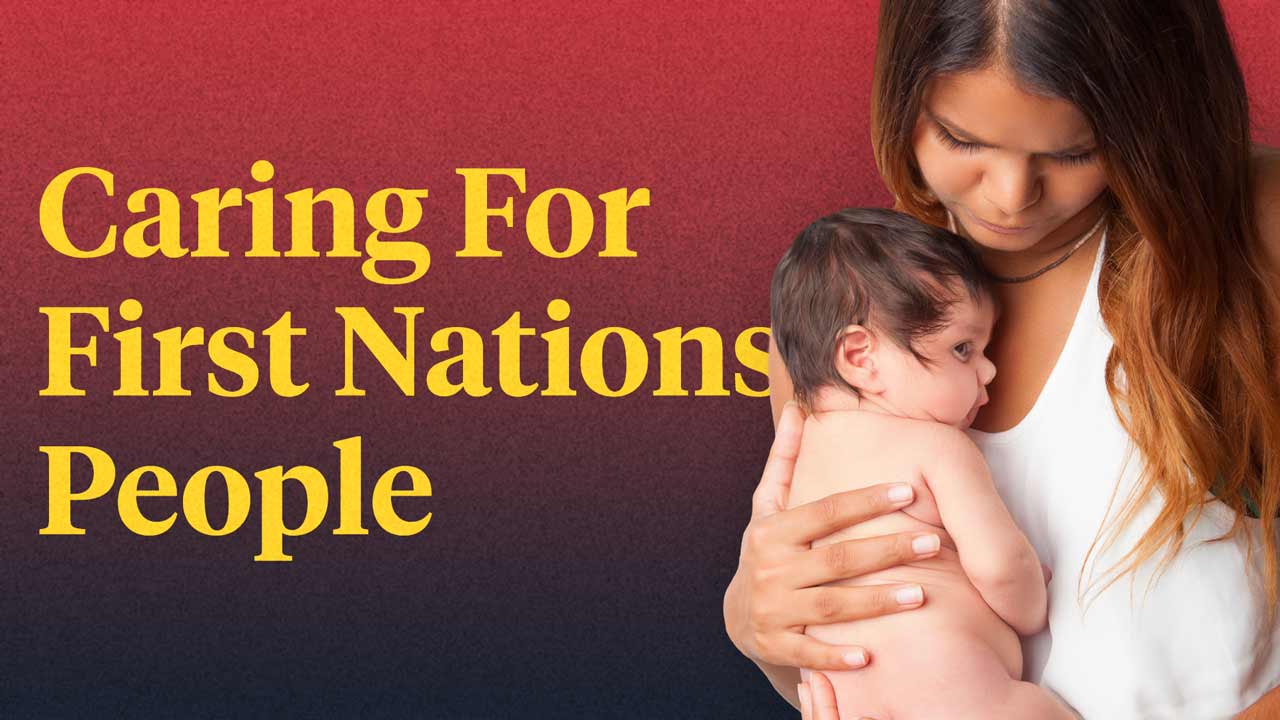First Nations peoples are diverse peoples with a variety of histories, cultures, languages and experiences.
In order to deliver appropriate and culturally competent care, it is essential to understand the care needs and health of First Nations people.
It is a national priority to close the gap between First Nations people and non-Indigenous Australians in healthcare, along with other areas including housing, education and employment (Healthdirect 2022).
Note: While this article provides general advice, it’s important to remember that First Nations peoples have diverse cultures, languages and experiences. Therefore, using a one-size-fits-all approach is inappropriate and fails to acknowledge this diversity. It’s essential to tailor your care to each individual and their specific needs.
First Nations Peoples
First Nations Peoples are:
- Aboriginal Peoples, who are the original peoples of mainland Australia, and
- Torres Strait Islander Peoples, who are the original peoples of the 274 islands located in the Torres Strait above Australia.
(Australian Government 2023)
Prior to European invasion there were more than 500 First Nations clan groups, and there were 250 distinct languages being spoken by First Nations peoples (Australians Together 2017; Narragunnawali 2020).
The Health of First Nations People
The life expectancy of First Nations people is significantly shorter than it is for non-Indigenous Australians:
| Men | Women | |
|---|---|---|
| First Nations people | 71.6 years | 75.6 years |
| Non-Indigenous Australians | 80.2 years | 83.4 years |
(NIAA 2023a)
In addition, the infant mortality rate is 1.9 times higher for First Nations children (NIAA 2023b), and the rate of maternal mortality among First Nations people is more than triple that of non-Indigenous people (AIHW 2023a).
The leading causes of mortality among First Nations people are ischaemic heart disease, diabetes, chronic lower respiratory disease and lung (and other related) cancers. Cardiovascular disease as a whole is also prevalent among First Nations people and is associated with hospitalisation and mortality (HealthInfoNet 2023).
Health issues experienced by a large number of First Nations people include:
- Mental health conditions and substance use disorders
- Injuries (e.g. falls, traffic accidents)
- Cardiovascular disease
- Cancer
- Musculoskeletal conditions (e.g. osteoarthritis and back problems).
(AIHW 2023b)
Understanding the Health Gap
First Nations people experience, overall, poorer health and earlier mortality than non-Indigenous Australians (DoH 2019).
This health gap between First Nations people and non-Indigenous Australians should be viewed in the context of the European invasion and its ongoing impact on First Nations people (Australians Together 2020b).
It is important to consider the social and cultural determinants of health, i.e. the context in which First Nations people grow, live, work and age. The determinants of health that may adversely affect the health of First Nations people include:
- Dispossession from land and culture
- Racism, discrimination and vilification
- Poverty and economic exclusion
- Institutional policies
- Child removal policies
- Inherited grief and trauma
- Loss of roles, cultures and statuses
- Incarceration and culturally-determined decisions and actions by the criminal justice system
- Separation from culture and identity
- Violence
- Lack of access to education or early childhood services
- Unemployment
- Low income
- Poor quality of housing.
(Sydney Metropolitan Local Aboriginal Health Partnership 2014; AIHW 2018a; Beyond Blue 2016)
In addition to adversely impacting physical and mental health and predisposition to disease, these determinants may also affect First Nations people’s ability to access and interact with healthcare services (Sydney Metropolitan Local Aboriginal Health Partnership 2014).
Social and cultural determinants and health risk factors may interact, as they are closely connected. For example, smoking (a health risk factor) is more likely to be undertaken if the individual is receiving a lower income, has not had access to education or is living in a lower socioeconomic area (AIHW 2018a, b).
Caring for First Nations Clients

Keep the following points in mind when caring for First Nations clients, keeing in mind that care should be tailored to each person’s individual needs and experiences:
- First Nations peoples are not a singular group; they are diverse peoples with different cultures, languages, experiences and needs.
- Consider the terminology you use when talking about and engaging with First Nations people. Preferred terminology may differ depending on the individual. Always ask someone how they prefer to be addressed. See this resource from Reconcilliation Australia as a starting point for more information about appropriate terminology.
- First Nations people may view health holistically, taking into account physical, cultural, social, emotional and spiritual factors. Ensure your care considers each client’s individual beliefs and values.
- Respect segregation between genders (men’s and women’s business), which is part of cultural practice in some First Nations communities.
- Understand the social and historical implications related to healthcare that may cause First Nations people to feel threatened, distrustful or disempowered.
- Consider the emotional stressors that First Nations people may experience, especially if they have travelled from a remote location.
- Work with First Nations people’s belief systems. Document their cultural views, including their concept of health, health beliefs, and cultural and gender-specific practices.
- Understand language differences between First Nations people and non-Indigenous people; for example, First Nations people may use English differently and some First Nations people may find direct communication confronting.
- Take note of non-verbal communication. The Queensland Department of Health’s Aboriginal and Torres Strait Islander Patient Care Guideline provides information about body language that may be used by First Nations people.
- Establish a culturally safe environment for First Nations people. For example, display Aboriginal and Torres Strait Islander flags and artworks, use First Nations resources (e.g. brochures and booklets) and seek advice from relevant First Nations personnel.
- Take note of any signs of pain and discuss pain management options in a culturally sensitive manner.
- Ensure medication is administered correctly; take note of any communication difficulties and engage an Aboriginal and Torres Strait Islander Hospital Liaison Officer if required.
- Be mindful and respectful of cultural beliefs.
- Always ensure that the client is comfortable before conducting a physical examination. Explain the need for the examination and ask if the client would like a support person to be present.
(Queensland Health 2014)
Building Rapport and Communicating Effectively With First Nations Clients
It’s essential to build rapport with First Nations clients, as this may help to overcome any fears or barriers and build trust. In order to build rapport and communicate effectively:
- Greet clients in a warm and friendly way
- Use non-threatening body language and tones of voice
- Ask the client where they are from and if they have visited the service before
- Identify a common view or topic with the client
- Tell the client a bit about yourself
- Explain processes and provide general information (e.g. waiting times, directions)
- Show personal interest in the client
- Provide clarity and address any concerns the client may have
- Listen, be patient and allow for silence
- Adopt a non-judgmental approach
- Speak in plain English and explain if necessary
- Avoid technical language and medical jargon
- Use open-ended questions
- Be an active listener
- Speak quietly if other people are nearby
- Simplify written material and forms if possible
- Use visual aids
- Ensure the client understands what has been said.
(Queensland Health 2014)
Overall, First Nations people are more likely to access healthcare organisations that:
- Engage in partnerships with local Aboriginal and Torres Strait Islander communities
- Acknowledge cultural differences
- Respect First Nations peoples’ cultural beliefs and customs
- Are physically accessible and affordable for First Nations people.
(ACSQHC 2016)
Conclusion
Being able to care for First Nations people in a culturally competent and respectful manner is essential in ensuring your clients feel comfortable accessing healthcare services effectively.
Note: This article is a starting point and we encourage you to undertake further research. As a starting point, see the following websites:
Topics
References
- Australian Commission on Safety and Quality in Health Care 2016, Overview: Guide to Better Care for Aboriginal and Torres Strait Islander Communities, Australian Government, viewed 25 September 2023, https://www.safetyandquality.gov.au/wp-content/uploads/2016/10/Overview-Guide-to-better-care-for-Aboriginal-and-Torres-Strait-Islander-communities.docx
- Australian Government 2023, Style Manual: Aboriginal and Torres Strait Islander Peoples, Australian Government, viewed 21 September 2023, https://www.stylemanual.gov.au/accessible-and-inclusive-content/inclusive-language/aboriginal-and-torres-strait-islander-peoples
- Australian Institute of Health and Welfare 2023b, Indigenous Health and Wellbeing, Australian Government, viewed 22 September 2023, https://www.aihw.gov.au/reports/australias-health/indigenous-health-and-wellbeing
- Australian Institute of Health and Welfare 2023a, Maternal Deaths in Australia 2015-2017, Australian Government, viewed 22 September 2023, https://www.aihw.gov.au/reports/mothers-babies/maternal-deaths-in-australia-2015-2017/summary
- Australian Institute of Health and Welfare 2018a, 6.7 Size and Sources of the Indigenous Health Gap, Australian Government, viewed 25 September 2023, https://www.aihw.gov.au/getmedia/f1d1c24c-2966-4e06-9609-d7a099f6d3af/aihw-aus-221-chapter-6-7.pdf.aspx
- Australian Institute of Health and Welfare 2018b, 6.6 Social Determinants and Indigenous Health, Australian Government, viewed 25 September 2023, https://www.aihw.gov.au/getmedia/4cb92d82-ce6a-44dd-bdc1-434ee7d6e849/aihw-aus-221-chapter-6-6.pdf.aspx
- Australians Together 2017, Colonisation, Australians Together, viewed 21 September 2023, https://australianstogether.org.au/discover-and-learn/our-history/colonisation/
- Beyond Blue 2016, Risk Factors Affecting Aboriginal and Torres Strait Islander People, Beyond Blue, viewed 25 September 2023, https://www.beyondblue.org.au/who-does-it-affect/aboriginal-and-torres-strait-islander-people/risk-factors
- Healthdirect 2022, Aboriginal and Torres Strait Islander Peoples’ Health, Australian Government, viewed 21 September 2023, https://www.healthdirect.gov.au/indigenous-health
- HealthInfoNet 2023, Overview of Aboriginal and Torres Strait Islander Health Status 2022, HealthInfoNet, viewed 22 September 2023, https://healthinfonet.ecu.edu.au/healthinfonet/getContent.php?linkid=691979&title=Overview+of+Aboriginal+and+Torres+Strait+Islander+health+status+2022&contentid=46464_1
- Narragunnawali 2020, Resource Guide - Languages, Narragunnawali, viewed 21 September 2023, https://www.narragunnawali.org.au/storage/media/page/languages-resource-guide-2020_XjLEe.pdf
- National Indigenous Australians Agency 2023b, 1.20 Infant and Child Mortality, Australian Government, https://www.indigenoushpf.gov.au/measures/1-20-infant-child-mortality
- National Indigenous Australians Agency 2023a, Aboriginal and Torres Strait Islander Health Performance Framework - Summary Report: Life Expectancy, Australian Government, https://www.indigenoushpf.gov.au/report-overview/overview/summary-report/4-tier-1-%E2%80%93-health-status-and-outcomes/life-expectancy
- Queensland Health 2014, Aboriginal and Torres Strait Islander Patient Care Guideline, Queensland Government, viewed 25 September 2023, https://www.health.qld.gov.au/__data/assets/pdf_file/0022/157333/patient_care_guidelines.pdf
- Sydney Metropolitan Local Aboriginal Health Partnership 2014, Social Determinants of Aboriginal and Torres Strait Islander Health Forum Report and Recommendations 2016, New South Wales Government, viewed 25 September 2023
 New
New 
